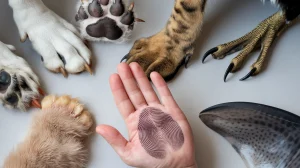- The Lifespan of Osteoclasts: How Long Do They Live?
- What is Monkfish average lifespan?
- What is Amberjack average lifespan?
- What is Sturgeon average lifespan?
- What is Barramundi average lifespan?
- What is Wahoo average lifespan?
- What is Shark average lifespan?
- What is Redfish average lifespan?
- What is Marlin average lifespan?
- What is Pompano average lifespan?
- What is Rainbow Trout average lifespan?
- What is Swordfish average lifespan?
- What is Anchovy average lifespan?
- What is Grouper average lifespan?
- What is Halibut average lifespan?
- What is Carp average lifespan?
- What is Pike average lifespan?
- What is Flounder average lifespan?
- What is Tilapia average lifespan?
- What is Sardine average lifespan?
Do Animals Have Fingerprints? Which Animals Have Unique Prints?

Have you ever wondered if animals have fingerprints, just like humans? It’s a fascinating question that has intrigued scientists and nature enthusiasts alike. While human fingerprints are well-known for their unique patterns, the idea of animal fingerprints is often overlooked. In this article, we’ll explore the intriguing world of animal fingerprints, discovering which creatures share this distinctive trait with us.
What Are Fingerprints
Fingerprints are the unique ridges and patterns found on the skin of our fingertips. These patterns are formed during fetal development and remain unchanged throughout our lives. For humans, fingerprints serve several purposes, including enhancing our grip, preventing slippage, and aiding in individual identification.
Do Animals Have Fingerprints
The short answer is yes, some animals do have fingerprints! However, these prints may not always resemble the familiar patterns we see on human fingertips. In animals, fingerprints can serve different purposes, such as improving grip, enhancing sensory perception, or even aiding in camouflage.

Which Animals Have Unique Fingerprints
Several fascinating creatures share the unique trait of having fingerprints:
- Primates. Our closest relatives, primates like gorillas and chimpanzees, exhibit fingerprint-like patterns on their fingertips. These patterns are remarkably similar to human fingerprints, suggesting a shared evolutionary history.
- Koalas. These adorable marsupials have unique fingerprint patterns that are often indistinguishable from human prints. This similarity has led to some interesting scientific studies.
- Other Mammals. While less common, some other mammals, such as certain species of bats and fish, have been found to possess fingerprint-like ridges or markings on their appendages.

Why Do These Animals Have Fingerprints
The development of fingerprints in animals is likely an adaptation that has evolved over time. One of the primary reasons for having fingerprints is to enhance grip and sensitivity. The ridges and patterns on the skin can provide increased traction and improve tactile perception, allowing animals to better interact with their environment.
How Are Animal Fingerprints Studied
Scientists study animal fingerprints using a variety of methods. One common approach is to compare fingerprint patterns between different species and individuals using advanced imaging techniques. These studies can help researchers understand the evolutionary history of fingerprints and their role in animal behavior and adaptation.

The fascinating world of animal fingerprints offers a glimpse into the remarkable diversity of life on Earth. While humans are well-known for their unique fingerprints, it’s clear that other animals have also developed this intriguing feature. By studying animal fingerprints, scientists can gain valuable insights into evolution, behavior, and the intricate connections between different species.



